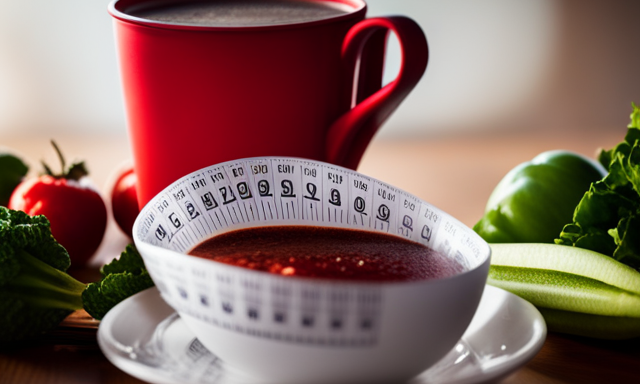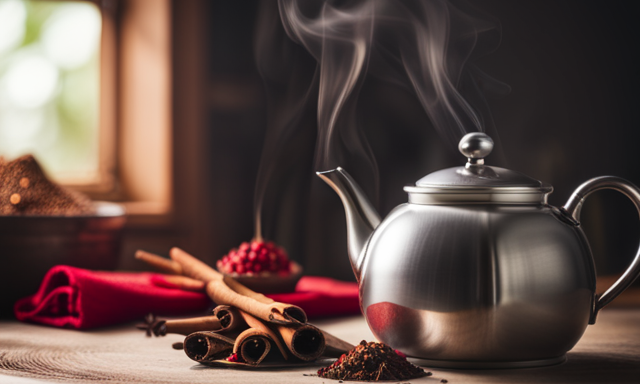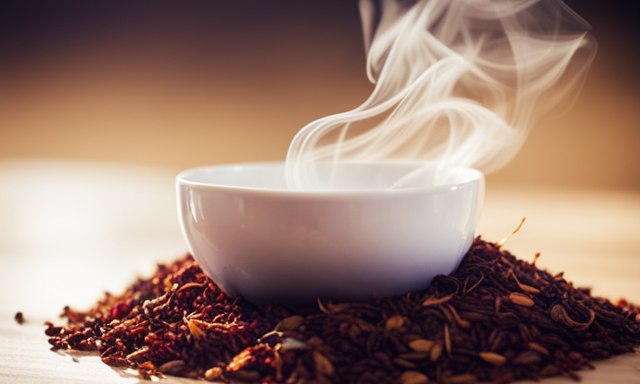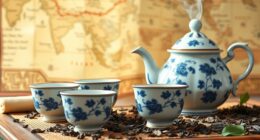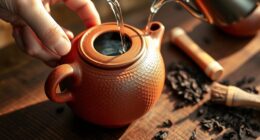As a self-proclaimed tea aficionado, I have had the pleasure of exploring a wide range of tea varieties from around the world. However, there is one tea that stands out among the rest, and that is African Rooibos. This exceptional tea, with its rich and robust flavor, has captured my taste buds in a way that no other tea has. It is a true gem in the world of tea.
Rooibos, derived from the Aspalathus linearis plant, is native to the beautiful landscapes of South Africa. Its vibrant red color and earthy aroma are an invitation to indulge in a truly unique tea experience. But it’s not just the taste and aroma that make African Rooibos special. This tea is also packed with health benefits, such as antioxidants and anti-inflammatory properties.
In this article, I will guide you through the process of brewing your own African Rooibos tea, ensuring that you achieve the perfect cup every time. From selecting the finest tea leaves to steeping them for optimal flavor, I will share my knowledge and expertise to help you embark on a delightful tea journey.
So, grab your favorite teapot and let’s dive into the world of African Rooibos tea.
Key Takeaways
- Strain Rooibos tea using a fine mesh strainer or tea filter to remove residual leaves and particles.
- Properly store Rooibos tea in an airtight container away from moisture, heat, and light to preserve freshness and aroma.
- Rooibos tea comes in different variations and blends, offering a distinct aroma and taste.
- Pay attention to brewing time and temperature, with a longer steeping time of 5-7 minutes at around 200°F (93°C) for full flavor extraction.
Introduction to African Rooibos Tea
Get ready to indulge in the rich and vibrant flavors of African Rooibos tea – a true delight for the senses! As a tea expert, I’m excited to share with you the fascinating history of Rooibos tea and its traditional uses.
Originating from the Cederberg region of South Africa, Rooibos tea has been consumed for centuries by the indigenous people of the area. They recognized its incredible health benefits and used it for its soothing properties and to alleviate various ailments.
The leaves of the Rooibos plant are carefully harvested, oxidized, and dried to create the distinctive red color and earthy flavor that’s characteristic of this tea. Rooibos tea is not only delicious but also packed with antioxidants and minerals. It’s caffeine-free, making it a perfect choice for those looking for a natural and healthy alternative to traditional teas.
Now that we understand the rich history of Rooibos tea, let’s explore the incredible health benefits it offers.
Understanding the Health Benefits of Rooibos Tea
One cannot ignore the numerous health benefits of rooibos tea; it is like a soothing elixir for the body and mind. Rooibos tea, also known as African red bush tea, is derived from the leaves of the Aspalathus linearis plant, native to the Cederberg region of South Africa. This caffeine-free herbal tea is rich in antioxidants, such as aspalathin and nothofagin, which help protect against oxidative stress and inflammation. Studies have shown that rooibos tea may improve heart health, support digestion, boost the immune system, and even have anti-cancer properties. Additionally, rooibos tea is known to be hydrating and may help with relaxation and sleep. However, it is important to note that excessive consumption of rooibos tea may have potential side effects, such as liver problems and allergies. It is always recommended to consult with a healthcare professional before incorporating any new herbal tea into your diet. Understanding the origins and cultivation of rooibos tea is essential to appreciate its unique qualities.
| Origins | Cultivation |
|---|---|
| Cederberg, South Africa | Sustainable farming practices |
| Indigenous to the region | Hand-picked and sun-dried |
| Rich in minerals and nutrients | No pesticides or fertilizers used |
Analyzing the potential side effects and risks of consuming rooibos tea is crucial for responsible tea consumption. It is generally safe for most people, but individuals with liver disease or hormone-sensitive conditions should exercise caution. Pregnant or breastfeeding women should also consult their healthcare provider before consuming rooibos tea. With proper knowledge and understanding, one can fully enjoy the health benefits of rooibos tea. In the next section, we will explore gathering the necessary ingredients and equipment for making African rooibos tea.
Gathering the Necessary Ingredients and Equipment
To gather all the necessary ingredients and equipment for preparing this delightful herbal tea, it’s essential to have a well-stocked pantry and a collection of specialized tea-making tools.
First and foremost, you’ll need high-quality African rooibos tea leaves. Look for leaves that are vibrant in color and have a distinct sweet and nutty aroma.
Additionally, you’ll need filtered water to brew the tea. Using filtered water ensures that there aren’t any impurities that could affect the taste of the tea.
Lastly, gather a teapot or teacup, a tea infuser or strainer, and a timer to ensure precise brewing.
Gathering these ingredients and tools will set the stage for a successful brewing process, allowing you to fully enjoy the rich flavors and health benefits of African rooibos tea.
Now, let’s move on to boiling water and preparing the tea leaves.
Boiling Water and Preparing the Tea Leaves
Now it’s time to heat up the water and get those tea leaves ready for brewing. Boiling water is a crucial step in making the perfect cup of African Rooibos tea. The water temperature plays a significant role in extracting the flavors from the tea leaves.
For Rooibos, it’s recommended to use water that’s reached a rolling boil. This ensures that the tea leaves release their full potential and create a rich infusion.
Next, it’s important to consider the quality of the tea leaves. Opt for loose leaf Rooibos tea, as it offers a superior taste and aroma compared to tea bags. Loose leaf tea allows for better water circulation and ensures a more nuanced flavor profile. Look for tea leaves that are vibrant in color and have a distinct aroma. These indicators suggest freshness and high-quality.
With the water boiling and the tea leaves at the ready, it’s time to move on to steeping the Rooibos tea for optimal flavor.
Steeping the Rooibos tea for optimal flavor is the next step in the process.
Steeping the Rooibos Tea for Optimal Flavor
Steeping the Rooibos tea is like an alchemical process, transforming the water into a soothing elixir that brims with the essence of the earth. To achieve optimal flavor, it’s essential to master the art of steeping.
Here are three different steeping methods to enhance your tea experience:
-
Traditional Method: Pour freshly boiled water over the tea leaves and let it steep for 5-7 minutes. This method brings out the full-bodied flavor and rich aroma of the Rooibos.
-
Cold Steeping: Place the tea leaves in cold water and refrigerate overnight. This method creates a refreshing, smooth tea with a delicate flavor.
-
Flash Steeping: Pour boiling water over the tea leaves and immediately strain it after 2-3 minutes. This method results in a lighter, more delicate infusion.
Experiment with these methods to find your preferred steeping time and brewing technique.
Now, let’s move on to adding sweeteners and enhancements (optional) to further elevate your Rooibos tea experience.
Adding Sweeteners and Enhancements (optional)
Enhance your Rooibos tea experience by adding your choice of sweeteners and enhancements. Rooibos tea has a naturally sweet and nutty flavor, but if you prefer a sweeter taste, there are several alternatives to consider.
One option is to add a teaspoon of honey, which not only adds sweetness but also complements the earthy undertones of the tea. Another option is to use stevia, a natural sweetener that has zero calories and doesn’t affect blood sugar levels.
If you’re looking for a unique twist, try adding a dash of cinnamon or a splash of vanilla extract to your Rooibos tea. These enhancements can elevate the flavor profile and provide a delightful sensory experience.
Additionally, Rooibos tea is known for its numerous health benefits, including its high antioxidant content and potential immune-boosting properties.
Now that your tea is perfectly sweetened and enhanced, it’s time to move on to straining and serving the Rooibos tea.
Straining and Serving the Rooibos Tea
Once you’ve infused your delicious Rooibos tea with all the delightful flavors and enhancements, it’s time to strain and serve this heavenly elixir to experience pure bliss in a cup.
Straining techniques are essential to remove any residual leaves or particles, ensuring a smooth and refined tea. To achieve this, you can use a fine mesh strainer or a tea filter. Gently pour the brewed tea through the strainer, allowing it to flow effortlessly into your teacup.
The vibrant reddish-brown color of the Rooibos tea is visually captivating, while its rich aroma tantalizes the senses. As you take your first sip, you’ll be greeted with a delicate sweetness and a hint of nuttiness, followed by a smooth and velvety texture.
To elevate your tea experience, consider serving it with a slice of lemon or a dollop of honey. These additions can enhance the flavor profile, adding a refreshing citrusy zing or a touch of natural sweetness.
Now that your cup of Rooibos tea is ready, let’s explore the next step in our tea journey: storing and preserving Rooibos tea for future use.
Storing and Preserving Rooibos Tea for Future Use
To ensure the longevity of your beloved Rooibos tea, it’s important to properly store and preserve it for future enjoyment. Rooibos tea is a delicate beverage that requires special attention to maintain its freshness and flavor.
One of the best storing techniques is to keep it in an airtight container, away from moisture, heat, and light. This will help to prevent the tea from absorbing any odors or flavors from its surroundings. Additionally, storing Rooibos tea in a cool, dark place will prolong its freshness and preserve its natural aroma and taste.
By following these simple steps, you can ensure that your Rooibos tea remains delicious and enjoyable for an extended period of time.
Now, let’s explore the different variations and flavors of Rooibos tea.
Exploring Different Variations and Flavors of Rooibos Tea
Discover the diverse range of flavors and unique variations of Rooibos tea that’ll tantalize your taste buds. As a tea expert, I’ve explored the world of Rooibos tea and discovered an array of exciting blends and infusion techniques that take this beverage to new heights.
From classic blends like Rooibos Vanilla and Rooibos Chai to more exotic combinations like Rooibos Earl Grey and Rooibos Berry, there’s something for every palate. Each blend offers a distinct aroma and taste, from floral and earthy to fruity and spicy. The color of the tea ranges from vibrant amber to deep red, and the texture is smooth and velvety.
By experimenting with infusion techniques, such as longer steeping times or adding a dash of honey, you can further enhance the flavors.
Now, let’s delve into the next section and uncover some tips and tricks for brewing the perfect cup of Rooibos tea.
Tips and Tricks for Brewing the Perfect Cup of Rooibos Tea
Unveiling the secrets to crafting an impeccable cup of Rooibos tea lies in mastering a few key techniques and principles. When it comes to brewing the perfect cup, it’s essential to pay attention to brewing time and temperature control. Rooibos tea requires a longer steeping time compared to other teas, usually around 5-7 minutes, to fully extract its flavors and aromas. As for temperature control, it’s crucial to use water that is around 200°F (93°C) to prevent the tea from becoming bitter. To help you understand the brewing process better, here is a table that showcases the recommended brewing time and temperature for Rooibos tea:
| Varieties | Brewing Time | Temperature |
|---|---|---|
| Traditional | 5-7 minutes | 200°F (93°C) |
| Honeybush | 4-6 minutes | 200°F (93°C) |
| Vanilla Rooibos | 5-7 minutes | 200°F (93°C) |
| Herbal Blends | 5-7 minutes | 200°F (93°C) |
Mastering the art of brewing Rooibos tea takes practice and experimentation, but by following these guidelines, you’ll be well on your way to enjoying a perfectly brewed cup every time.
Frequently Asked Questions
How long does it take for rooibos tea to steep?
To achieve the perfect steeping time for rooibos tea, it is recommended to steep it for 5-7 minutes at an optimal temperature of 208°F (98°C). This allows the tea to fully release its flavors and aromas, resulting in a delightful sensory experience.
Can I use regular tea bags instead of loose leaf rooibos tea?
Using regular tea bags as a substitute for loose leaf rooibos tea is not recommended. Loose leaf rooibos tea provides a better flavor profile and contains more antioxidants, which offer numerous health benefits.
Does rooibos tea have caffeine?
Rooibos tea is naturally caffeine-free, making it a great choice for those looking to avoid caffeine. Its rich flavor and numerous health benefits make it a popular choice among tea enthusiasts.
Can I drink rooibos tea if I have allergies?
Drinking rooibos tea during pregnancy is generally considered safe, but it’s always best to consult with your doctor. Rooibos tea has health benefits for allergies due to its anti-inflammatory properties, providing relief for symptoms.
How long can I store brewed rooibos tea before it goes bad?
The shelf life of brewed rooibos tea depends on how it is stored. When stored in an airtight container in the refrigerator, it can last up to 2-3 days while maintaining its flavor and quality.
Conclusion
In conclusion, African Rooibos tea is a delightful beverage that not only offers numerous health benefits but also provides a unique sensory experience. Its vibrant red color, earthy aroma, and smooth texture make it a pleasure to drink.
Just like a sunset painting the sky with warm hues, sipping on a cup of Rooibos tea transports you to a serene and tranquil state. With the knowledge and techniques shared in this article, you can now confidently brew the perfect cup of Rooibos tea and embark on a journey of tea appreciation.
Cheers to your tea adventure!


